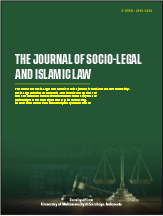Legal Protection for Defamation Suspects Who Spread Facts on Social Media Reviewed from the ITE Law
DOI:
https://doi.org/10.30651/jssl.v3i1.23904Abstract
This research wants to discuss the problem of defamation that is suspected of spreading facts on social media. This research is intended to understand the interpretation of Article 27 of the ITE Law as well as the Joint Decree of the Minister of Communication and Information Technology, the Attorney General, and the Chief of the National Police of the Republic of Indonesia on Implementation Guidelines for Certain Articles in the ITE Law. The research approach used is the Gap and Socio-Legal Analysis Study, which is an approach to study the implementation of the law on criminal procedure law and its relation to social impacts on law enforcement in Indonesia. The results of the study show that law enforcement officials always use Article 27 of the ITE Law to ensnare defamers on social media and override the Joint Decree of the Minister of Communication and Information, the Attorney General, and the Chief of the National Police of the Republic of Indonesia, so that the judge's decision is considered contradictory to the existing provisions.
Keywords: Criminal Code, Defamation, ITE Law, Law Enforcement Officials
References
Ali, M., Ali, M., & Ahmad, Z. S. A. S. (2023). The Driving Factors for Recidivism of Former Terrorism Convicts in Socio-Legal Perspective. Journal of Indonesian Legal Studies, 8(1). https://doi.org/10.15294/jils.v8i1.69445
Dong, A., Zhang, H., Zhou, X., & Yuan, D. (2017). On Analytical Achievable Rate for MIMO Linear Interference Alignment with Imperfect CSI. Wireless Personal Communications, 95(2). https://doi.org/10.1007/s11277-016-3824-5
Harradine, M. (2022). Defamation Law and Epistemic Harm in the #MeToo Era. Australian Feminist Law Journal, 48(1). https://doi.org/10.1080/13200968.2022.2146303
Hayata, E., Nakata, M., Takano, M., Umemura, N., Nagasaki, S., Oji, A., Maemura, T., Katagiri, Y., & Morita, M. (2019). Safety of uterine fundal pressure maneuver during second stage of labor in a tertiary perinatal medical center: A retrospective observational study. Taiwanese Journal of Obstetrics and Gynecology, 58(3). https://doi.org/10.1016/j.tjog.2018.10.033
I Putu Pande Juli Artana, I Nyoman Gede Sugiartha, & I Made Minggu Widyantara. (2022). Sanksi Pidana terhadap Pelaku Pencemaran Nama Baik Melalui Media Sosial. Jurnal Interpretasi Hukum, 3(1). https://doi.org/10.22225/juinhum.3.1.4633.25-30
Kurniati, K. (2022). PENEGAKAN HUKUM TERHADAP PELAKU TINDAK PIDANA PELECEHAN SEKSUAL MELALUI MEDIA SOSIAL DALAM PASAL 27 AYAT 1 UU ITE NOMOR 19 TAHUN 2016. Disiplin : Majalah Civitas Akademika Sekolah Tinggi Ilmu Hukum Sumpah Pemuda, 28(2). https://doi.org/10.46839/disiplin.v28i2.75
Muldani, T. (2022). Implikasi Awal Penerbitan SKB UU ITE Pasal 27 Ayat (3). MUKASI: Jurnal Ilmu Komunikasi, 1(2). https://doi.org/10.54259/mukasi.v1i2.857
Octarina, N. F., Sudiawati, S., & Mardika, M. (2022). The Application of the Conditio Sine Qua Non Principle on the Crime of Damage through Social Media. Lambung Mangkurat Law Journal, 7(1). https://doi.org/10.32801/lamlaj.v7i1.303
Patel, N., Young, R., Hussaini, S., Jawed, A., & Steinberg, H. (2017). Accounting Information Systems and Supply Chain Management With Cross Cultural Comparisons. Allied Academies International Conference: Proceedings of the Academy of Accounting & Financial Studies (AAFS), 22(1).
Reski Badillah, Andi Yulia Muniar, Abd. Rahman, Febri Hidayat Saputra, Mansyur, & Supriadi Sahibu. (2023). Digital Forensic Evidence Analysis In Revealing Defamation On Social Media (Twitter) Using The Static Forensics Method. Ceddi Journal of Information System and Technology (JST), 2(2). https://doi.org/10.56134/jst.v2i2.45
SARI, N. L. A. (2023). PENERAPAN PASAL 28 AYAT (1) UNDANG-UNDANG ITE DALAM PERSPEKTIF KEPUTUSAN BERSAMA MENTERI KOMUNIKASI DAN INFORMATIKA, JAKSA AGUNG REPUBLIK INDONESIA DAN KEPALA KEPOLISIAN NEGARA REPUBLIK INDONESIA. GANEC SWARA, 17(1). https://doi.org/10.35327/gara.v17i1.378
Satria, I., & Agung, I. G. (2023). SETTLEMENT OF DEFAMATION CRIMINAL CASES THROUGH SOCIAL MEDIA WITH A RESTORATIVE JUSTICE APPROACH. TANJUNGPURA LAW JOURNAL, 7(1). https://doi.org/10.26418/tlj.v7i1.61344
Waisnawa, G. A. (2018). KEBIJAKAN FORMULATIF PENGATURAN CYBERBULLYING SEBAGAI SALAH SATU BENTUK TINDAK PIDANA CYBERCRIME DI INDONESIA. Jurnal Magister Hukum Udayana (Udayana Master Law Journal), 6(4). https://doi.org/10.24843/jmhu.2017.v06.i04.p03
Downloads
Published
How to Cite
Issue
Section
License
Copyright (c) 2024 Asis Asis

This work is licensed under a Creative Commons Attribution 4.0 International License.






